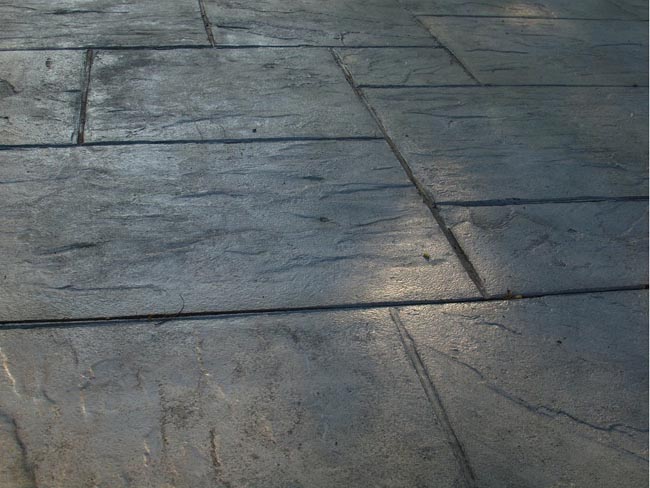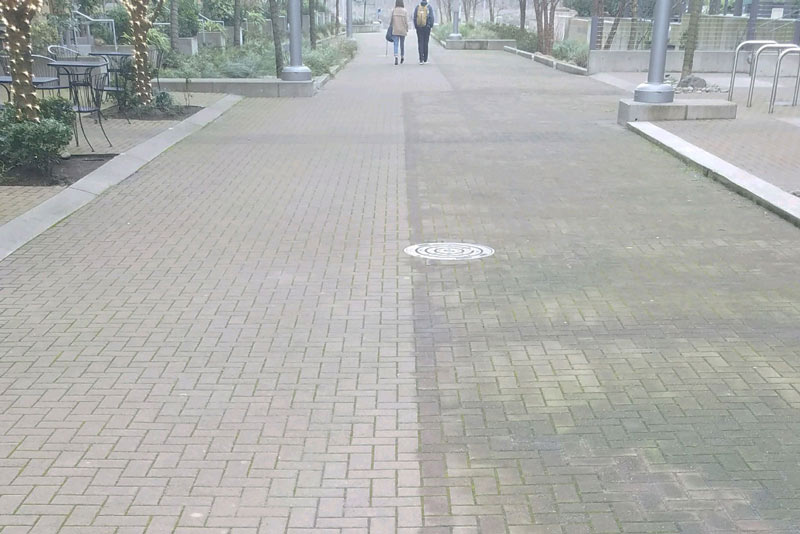Everything You Need to Know About Concrete Sealers
Concrete is a very robust material and can last for decades without needing to be replaced. So why bother sealing it? While concrete is a very durable material, sealing concrete can have a number of benefits that you might want to pay attention to. You’ll want to make sure to pressure wash your surfaces before sealing them to get any dirt, grime, debris, efflorescence or contaminants cleared out so the sealant can work effectively. Pressure washing also makes the concrete look brighter and better.
Benefits
One of the most important functions of sealant is to act as a barrier to moisture. Water can end up causing concrete to deteriorate, especially in places that experience temperatures below the freezing point of water. When water freezes into ice it slightly expands. This can cause serious damage to your concrete, potentially leading to cracks or degradation. Sealing the concrete will keep unwanted moisture out of the porous concrete, increasing its longevity.
Another benefit of blocking moisture is protection against mold and moss. Mold and moss depend on moisture to grow and survive, and because unsealed concrete is a porous material, it holds a lot of moisture. This can lead to slick and unsightly moss infesting your hardscapes.
Certain types of sealers offer aesthetic properties such as texture, color and gloss. If you have decorative concrete, like patios or walls, you can enhance their looks with the right sealer.
Sealers
There are two main types of concrete sealers, topical and penetrating. Topical sealers are coatings that stick to the surface of concrete. They generally will change the texture of the concrete by reducing traction and change the appearance by changing color or adding gloss. Topical sealers are generally used for indoor floors and surfaces and occasionally outdoors.
Penetrating sealers soak into the concrete and chemically react with it. These sealers generally don’t change the texture or look of the concrete. Penetrating sealers are most often used for exterior concrete sealing needs.

Topical
There are 4 main types of topical sealers; acrylic, epoxy, polyurethane and polyurea. These sealants form a protective film over the top of concrete surfaces to add defense against scuffs, stains and moisture problems. These sealers are often slippery when wet, so anti-skid additives are regularly recommended.
Acrylic sealers are affordable and straightforward in their application. There are 2 categories of that acrylic sealers come in, water-based and solvent-based. Solvent-based sealers usually perform better than their water-based counterparts, but usually have higher amounts of volatile organic compounds, meaning they are less environmentally friendly and require greater care when using and storing. Solvent-based acrylics generally leave a high gloss finish and water-based a low gloss or satin finish.
Though they can be used on indoor or outdoor surfaces, their life-span is significantly lower outdoors due to the elements. Even though most acrylics are UV resistant, they can become brittle in the intense heat of the sun. Outdoors their longevity is about 1 year, versus 3 years indoors. Surface preparation before application is generally the simplest in comparison to other sealers. Just make sure the surface is clean and clear of dirt, oil, and other contaminants.

Epoxy sealers are generally more resilient and perform better than acrylic sealers, but they are significantly more expensive. They come in water or solvent based options as well as 1-component or 2-component options. Again, solvent based epoxies usually perform better than water-based ones and 2-component systems work better that 1-component ones.
Because epoxies are generally not UV resistant, they are usually used on high traffic interior concrete. Preparation of the surface is key to the success of epoxy sealers. In most cases epoxies are sensitive to moisture and are not breathable, so the surface should be dry. If moisture is trapped under the layer of epoxy, this could lead to the sealer to fail to adhere properly. Often it is necessary to profile the concrete before adding epoxy sealer, this can look like acid etching, grinding, shot blasting, sand blasting or scarifying the surface. Epoxies generally have a lifespan of 5-7 years.
Polyurethane sealers are more durable and more expensive than acrylics or epoxies. Many of them are UV resistant and can be used on interior or exterior concrete. They are similar to epoxies as far as preparation. They come in water or solvent based as well as 1-component or 2-component options. The surface should generally be dry when applying and should be acid etched, sandblasted, shot blasted, grinded, or scarified to promote adhesion.
Two main categories of polyurethanes are available for use; Aromatic, non-UV resistant and generally used indoors, and Aliphatic, UV resistant and more widely used for both indoors and outdoors. The lifespan of these sealers is usually 7-10 years.
Polyureas are unmatched in their performance among topical sealers, and are the most expensive of the options. They are very UV, chemical, abrasion and impact resistant and can last more than 10 years. Unfortunately, these sealers are very difficult to apply. They require specialized equipment and, because the cure time is so quick, it can cause problems in the way of fixing mistakes and adding multiple coats.
These sealers have higher failure rates than the others because they are difficult to apply and because they are sensitive to surface preparation. The surface needs to be profiled before application. If applied properly, polyureas are unmatched among the topical sealers.
There is a type of polyurea that has a slower curing time, called a polyaspartic. They offer a lot of the benefits of other polyureas, without the drawbacks of difficult application.
Penetrating
There are 5 main types of penetrating sealers; silicates, silanes, siloxanes, siliconates and fluorinated. These sealers are a good defense against oil stains, tire marks, de-icing salts, water damage, dirt, mud, mold and chemicals. Penetrating sealers differ from topical sealers in that instead of forming a barrier on top of the surface, these sealers penetrate into the pores of the concrete and chemically react with it to form a barrier. They can be classified in a few ways; densifiers and hardeners, water repellents and oil and water repellents.
The trick with effectively using penetrating sealers is to match porosity with the molecular size of the sealer to maximize penetration into the concrete. The 5 types in order from largest to smallest molecular size areas follows: siloxanes, siliconates, silicates, silanes and fluorinated.

Siloxanes are a good option for highly porous concrete, brick or other porous masonry. They are hydrophobic and work very well for repelling water, dirt, salts and other contaminants. Because of their large molecular size, siloxanes are more prone to weathering and usually have a lifespan of 3-5 years. Concrete must be fully cured before application.
Siliconates have a medium molecular size and are a versatile sealer. They are good for driveways, sidewalks, floors, etc. They are hydrophobic and are good for repelling moisture, dirt, salts and other contaminants. Certain siliconates can be used on freshly poured concrete and act as a curing agent. Higher end siliconates can last 7-10 years.
Silicates are ideal for dense concrete that has been troweled or polished. Unlike the other penetrating sealers that are hydrophobic or oleophobic, silicates are densifiers and hardeners. They don’t repel water so much as they fill capillaries and block water and debris from breaching the surface. Though it doesn’t act as a curing agent, a silicate sealer can be applied to fresh concrete. Because these sealers are densifiers and hardeners, they will last as long as the concrete lasts, having an extremely long lifespan.
Silanes are great for dense concrete used for parking garages, bridges and vertical structures. These sealers are hydrophobic and great for repelling water, dirt, salts, etc. Surfaces should be sufficiently cured before application. The lifespan of silane sealers is usually 7-10 years.
Fluorinated sealers much more expensive than other penetrating sealers. They are oleophobic and hydrophobic, making them great for repelling water, oil, dirt, and many other contaminants. They are very UV and heat resistant. Because of the small size of their molecular structure, these sealers are best used on very dense concrete like machine troweled or polished concrete. Surfaces should be fully cured before application.
Conclusion
There are a lot of different types of sealers. It’s important to choose the right sealer for the concrete you want to seal. If you are looking for something that changes the look of your surface and offers stain resistance, especially for indoor use, then you probably want to go with a topical sealer. If you are looking for protection from the elements like moisture, freeze/ thaw and salts, especially for outdoor use, then you probably want to go with a penetrating sealer. SNUGS has been applying sealant to masonry for more than 25 years and knows how it can really help protect the investment and keep it clean as long as possible.
Snugs Pro Wash, Inc, dba SNUGS Services, has been providing high quality Pressure Washing Services in Portland, OR since 1995. Started as a residential pressure washing and roof cleaning service, SNUGS is now one of the leading exterior cleaning companies in the Northwest. From our humble beginnings as a man with a truck and a trailer we have grown to become a multi-million dollar company serving corporate customers, name brands, and mom and pop companies alike.